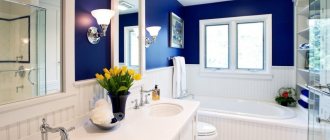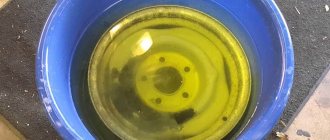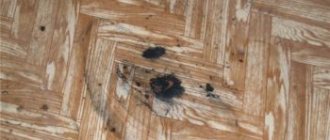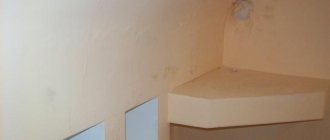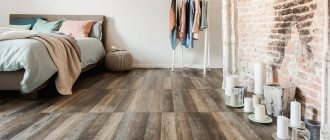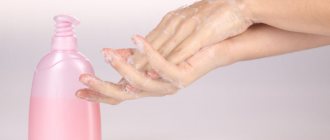During use, scuffs and scratches may appear on the tiles. Sometimes they are not noticeable at all and can only be seen when cleaning surfaces. However, various, even minor defects always cause inconvenience. The best option to restore the aesthetics of the coating is to replace the area of the damaged tile with a new one. However, this is not always possible, since not every person keeps a supply of new coating. To remove scuffs and scratches from tiles, you can resort to some effective methods.
Polishing porcelain tiles on the floor
To restore the original shine of a floor surface covered with glazed or glossy porcelain tiles, cleaning with cleaning products alone is not enough. When walking on the floor, through tiny grains of sand and other hard debris, many tiny scratches are formed on the decorative surface, into which dust and other contaminants accumulate. As a result, the porcelain tile flooring becomes dull, and regular washing and cleaning are ineffective. In this case, the problem is solved by polishing porcelain stoneware yourself or by hiring professionals who will return the flooring to its former shine using specialized equipment.
Polishing tools and materials
If we are talking about the restoration of large floors lined with artificial stone, you cannot do without professional polishing tools. This type of equipment includes electric drive floor polishers, which are characterized by high productivity. But a professional tool for polishing porcelain stoneware floors costs a lot, so purchasing it for private use is not rational. If you need to polish a small ceramic surface at home, it is better and cheaper to use a tool that matches the working volume.
What do homeowners use if they need to polish glossy porcelain tiles, for example? There are two ways to solve the problem. The first is applicable if the area of the polished surface is not at all large. Then the issue is resolved by using hand tools and special polishing agents produced by various manufacturers.
When you need to restore the appearance of a porcelain stoneware coating on a surface with an area of 4-5 m2 or more, it is better to use an affordable power tool, which is also available in almost every home - an angle grinder, better known as an angle grinder. There are many attachments available for this versatile tool, including those for polishing surfaces made of various materials. For polishing porcelain stoneware and smooth natural stone surfaces, felt discs are used that are placed directly on the working axis of the tool. Another option is a replaceable felt attachment, attached using the Velcro principle to a universal disk mount, which, in turn, is fixed on the rotating axis of the angle grinder.
In addition to the necessary tools, to fully polish a porcelain stoneware surface, you will need special compounds designed for these purposes. For example, when polishing glossy porcelain stoneware, various products based on liquid wax are used. After treatment with this composition, not only the former attractiveness and shine of the ceramic floor cladding is restored, but also the anti-slip properties of the smooth surface are imparted. In rooms where there is contact with water or simply high humidity, it is advisable to use a porcelain tile floor polishing paste containing water-repellent silicone.
Porcelain stoneware floor panels: layout options and manufacturers
When purchasing a polishing paste for processing porcelain tile flooring, ask your consultants for the intended purpose of the product - not all compositions are universal and suitable for all types of porcelain tiles.
Polishing technology
It is clear that there is a difference between using a diamond polishing sponge to polish porcelain tiles by hand and using a professional polishing pad. But the sequence of working stages when using tools and mechanisms of varying complexity and productivity does not change significantly. Polishing a porcelain stoneware floor works like this.
- The surface is thoroughly cleaned of dirt, dust, and solid particles. For this purpose, dry and wet floor cleaning is used.
- A porcelain tile polishing agent is applied to the cladding in a thin layer, evenly and without gaps. Depending on the technology used (when it comes to professional restoration of the coating), two layers of polishing agent may be applied.
- After the specialized paste has dried, the surface is mechanically polished using felt nozzles.
As a result of such restorative treatment of porcelain stoneware floor cladding, the coating returns to its original appearance, matte or glossy shine (depending on the type of porcelain stoneware used in the finishing). In addition to visual appeal, polishing provides protection of the decorative surface from mechanical and chemical damage, exposure to excess moisture, thereby extending the service life of the facing material.
So that polished porcelain tiles do not fade and retain their shine | With your own hands
Floor lined with polished porcelain stoneware
, requires more careful care and protection from dirt compared to unpolished.
What operating rules should be followed to prevent its surface from becoming dull?
CARE OF POLISHED PORCELAIN TILES
Features of the care and protection of polished porcelain stoneware from contamination are associated with its processing technology.
After firing, the rough surface of the tiles is polished in several stages with special diamond discs, gradually replacing them with discs with a finer grain size.
As a result, the top rough layer disappears, and a material with a glossy surface and a visual effect of color depth is obtained. It is used primarily for interior decoration of floors and walls, and also produces amazingly beautiful countertops, window sills, and stair steps.
To preserve the beauty of floors and walls lined with polished porcelain stoneware, you should follow a few simple rules, starting right from installation.
Means and rules for daily care of porcelain tiles
It is not difficult to clean porcelain tile flooring from common contaminants. It is enough to vacuum the surface, getting rid of solid particles, and then do a wet cleaning with plain water or a weak soap solution. It is not advisable to wash the floor without first removing solid debris, especially when facing with glossy porcelain tiles - fine sand present in the dust can make small scratches on the surface of the tiles, which over time will lead to the need to polish the porcelain tiles. Matte artificial stone is the least susceptible to mechanical damage and the influence of chemically active substances, therefore, with such cladding, the choice of means and methods for cleaning the surface is not limited.
Problems often arise with cleaning structured porcelain tiles, which have a relief decorative surface, due to which some substances eat into the tiles, and it can be difficult to wash off the resulting stain. Specialized cleaning products designed to remove dirt on porcelain tiles will help here. The most famous and reputable manufacturer of such products is the German company Glutoklin (Pufas), which offers a line of substances for cleaning porcelain tile cladding from various contaminants. Here are the types of dirt on the tile surface that this brand has special products to combat:
- wax, fat, oil stains;
- adhered remains of cement and tile grout;
- stains from organic dyes;
- streaks of rust.
In addition, Glutoklin offers a variety of cleaning and care products for porcelain stoneware, from detergents for daily cleaning to all kinds of protective impregnations for artificial stone.
Nothing prevents you from caring for porcelain tiles with products from other manufacturers, but it is important to pay attention that they are intended specifically for porcelain tiles.
How to remove traces of aluminum from tiles?
Aluminum
Stripes on ceramic
tiles
can be removed and are not that difficult to do.
You need to pour baking soda onto a soft cloth and rub the tile
. You can also moisten this cloth with sunflower oil. It's simple.
Interesting materials:
How to update the Adobe Flash Player plugin in Opera? How to update Lenovo Tab 2 tablet? How to update the plastic in a car interior? How to update Play Market on a tablet? How to update Play Market on an old tablet? How to update software via iTunes? How to update the software on your watch? How to update software on Huawei? How to update software on Honor? How to update software on Macbook Air?
Methods for restoring porcelain floor tiles
Types of porcelain tiles for floors and their characteristics
Regular proper care of ceramic floor coverings and the use of protective compounds significantly prolong the wear of the floor covering. But long-term use still inevitably leads to the need to restore the surface. The main method of restoring a porcelain stoneware floor surface is to deep grind the facing material. In small areas, it is possible to polish porcelain tiles with your own hands, although preference is given to the services of professionals who, using specialized equipment, can give the floor cladding its original appearance.
Grinding
A feature of many types of porcelain stoneware is the deep structure of the tile substance. This makes it possible to sand the top layer of the coating (up to 0.5 mm) without changing the decorative texture. Complete restoration of porcelain stoneware, carried out by professional teams, consists of several successive stages.
- Repairing large damage, removing grout between tiles and filling the joints with fresh mortar.
- Mechanical leveling of the floor surface with removal of significant unevenness (coarse diamond abrasive is used).
- Fine grinding of porcelain stoneware coating, with each subsequent pass the abrasive grain size decreases.
- Polishing the surface using a fine-grained abrasive paste, during which minor scratches and abrasions are removed, and the original color and shine of the cladding are restored.
- Treatment of porcelain tiles with hydrophobic compounds that repel water and increase the resistance of the material to various organic pollutants and chemically active substances.
Professional polishing of porcelain tiles has different prices, depending on the region and the range of additional services. The cost of work for one of the companies is shown in the table.
| № | Name of service | Cost in USD per m2 |
| 1 | Cleaning and sanding porcelain tile flooring | From 10 |
| 2 | Deep processing of porcelain stoneware coating | From 20 |
| 3 | Treatment with hydrophobic impregnation | From 15 |
| 4 | Cleaning the porcelain stoneware coating from heavy dirt followed by polishing | From 15 |
Restoration of scratches and chips
To seal large damage on the surface of porcelain stoneware, those that cannot be corrected by grinding, the sealing method is used. The basis of the material for such restoration of porcelain tiles is usually one of the types of polyester glue. By adding various dyes to the glue, a mastic is prepared that can not only firmly seal a pothole or large crack in an artificial stone, but also reflect its texture as accurately as possible so that the seal in the coating is minimally noticeable.
At home, it is possible to restore large damages with epoxy glue, which is almost as strong as artificial granite. However, it can be difficult to choose the right color and decorative parameters on your own.
Why polish laid porcelain tiles?
This material is highly durable and hard, but even it ages over time. Moreover, despite its high wear resistance, the polished surface of porcelain stoneware is easily damaged by materials that have a similar hardness. As a result, the surface becomes covered with scratches, abrasions and cracks. That’s why you have to periodically polish the already laid porcelain stoneware.
True, it is unlikely that you will be able to do this yourself due to the complexity of the technological process. Before polishing, grinding should be carried out to remove the top damaged layer. This operation requires equipment and grinding pastes. Based on the condition of the surface, nozzles and paste for grinding are selected.
After grinding, polishing begins using a rotary machine. There are special attachments for it, which are also called diamond substrates (pads). They are a synthetic polishing wheel onto which diamond grains of varying hardness are applied.
Removing large scratches and large chips on tiles
Large chips are unlikely to be masked with paint. Of course, the chip and scratch will match the tone of the tile and will become less noticeable, so, as a last resort, this is what you should do. But if possible, it is better to carry out a more thorough renovation, especially since it will not require anything special.
You need to stock up on alabaster, which is used to restore tiles. Alabaster can be used to fill even the deepest scratches and cracks in tiles. If you try, you can restore a corner or edge of a tile that has been completely knocked off. And only after that the repaired tiles are sanded with sandpaper and then painted with acrylic paint or ceramic paint.
The quality of tile repair will depend entirely on how well you choose the paint. Ideally, the paint should be the same color and shade as the tile. This can be achieved if you use special dyes for paint, which are added to the paint in the right quantities.
It’s not easy to guess the ideal amount of dye, but you can conduct several experiments in an inconspicuous area, somewhere behind the furniture, and choose a shade that matches the shade of the tile as closely as possible.
The rules for operating a glass-ceramic hob include not only constant proper care and maintenance of cleanliness, but also the use of suitable utensils. Failure to comply with these rules can lead to the appearance of defects that spoil its appearance. Even small scratches on a glass-ceramic hob immediately become noticeable, so if they occur, immediate action should be taken.
Repairing scratches and small chips on tiles
If a scratch or small chip(s) appears on the tile, you can use the simplest method of masking - paint. Of course, not just any paint can be used. Craftsmen advise using ceramic paint or acrylic paint for restoration.
Before work, the damaged area of the tile must be cleaned with fine sandpaper. Next, the surface of the tile is thoroughly wiped to remove dust and possible dirty stains.
After preparation, the tiles can be painted. The best result is obtained if you apply several thin layers of paint to the damaged area of the tile, rather than one thick layer.
Causes of damage
The glass-ceramic panels used to make hobs are strong enough to support the weight of heavy pots and pans. However, utensils that were used for cooking on a gas stove will not be suitable for these purposes. Using pots with thick or uneven bottoms or aluminum cookware will not only reduce the efficiency of the glass-ceramic hob, but may also cause visible marks on the surface. In addition, melted plastic and sugar can ruin the appearance of the product.
While stains and dirt can still be dealt with using various means, cracks and scratches can become a real problem. The appearance of scratches on a flat and smooth surface of the plate can be caused by:
- Using cleaning products containing abrasive substances.
- Using metal scrapers, brushes and sharp objects to remove dirt (hard-bristled dishwashing sponges can also leave marks on a smooth surface).
- A pointed impact (for example, when a metal lid or sharp object falls on a glass-ceramic surface).
- Contact with water or liquid food on a hot burner.
- Place a pan with a wet bottom on a hot burner.
How to close holes in bathroom tiles?
You can fill holes in the tiles with epoxy resin. To do this, buy dyes that are suitable for the resin. First, clean the holes from dirt. The hardener is poured into the resin, mixed thoroughly, then the dye is combined with the resin so that the color of the resin and the tile matches.
Interesting materials:
What is better to put on the floor at the dacha? What is better to put on the floor on the loggia? What is better to lay laminate or linoleum on the floor? What is better to lay on the floor? What is better to lay on a warm floor? Is it better to take creatine or protein? Which is better, squats or deadlifts? What is better, a down jacket with down or synthetic padding? What is better solvent or acetone? Which is better Deadlift or Romanian deadlift?
Methods for removing scratches from glass ceramics
If cracks or deep scratches appear on the surface of the glass-ceramic stove, you will not be able to get rid of them on your own. In this case, only service center specialists will be able to restore the original appearance of the product. Minor surface defects can be dealt with at home, but this will not be so easy. There are several ways to remove scratches from a ceramic slab, the choice of which depends on the nature and extent of the damage.
Reading time: 1 minute
How to wash porcelain tiles without scratches or damage in order to keep the stone tiles safe and sound? This material is often used for masonry in the bathroom and kitchen, which often raises questions regarding cleaning methods and products for this component of interior cladding. Video materials
in the article and our tips can help you choose high-quality materials for regular washing and care of such a beautiful construction decoration option.
To get the maximum return on interior beauty from your renovation investment, follow the rules below for caring for granite tiles. This will help you find out whether porcelain tiles can be washed and what tips to follow.
Water
You should use only filtered and boiled water for this procedure. It will not leave streaks, as is the case with chlorinated tap water. The rags should be soft, without hard sides, and after washing the tabletop should be dried well with a hairdryer or maximum ventilation.
Raid
To get rid of plaque, wipe the countertop with distilled water. Then you can remove mineral salts and stains with a dry towel. The method can be used an unlimited number of times.
Tile
If food particles or vapors get on your granite tiles during cooking, blot up the moisture with a paper towel without spreading the residue across the surface. Abrasives will leave small scratches, causing oils and food to get into the cracks, making the stain bigger each time. Cleaning out small indentations will be more difficult. Be careful with wine and chocolate - excess stains will make the porcelain tiles dull even after cleaning.
If you don’t know how to clean the primer from porcelain tiles, use soap solutions where plain water cannot cope with the stains. Keeping it clean will make it easier to remove a fresh stain than one that has been there for a week.
